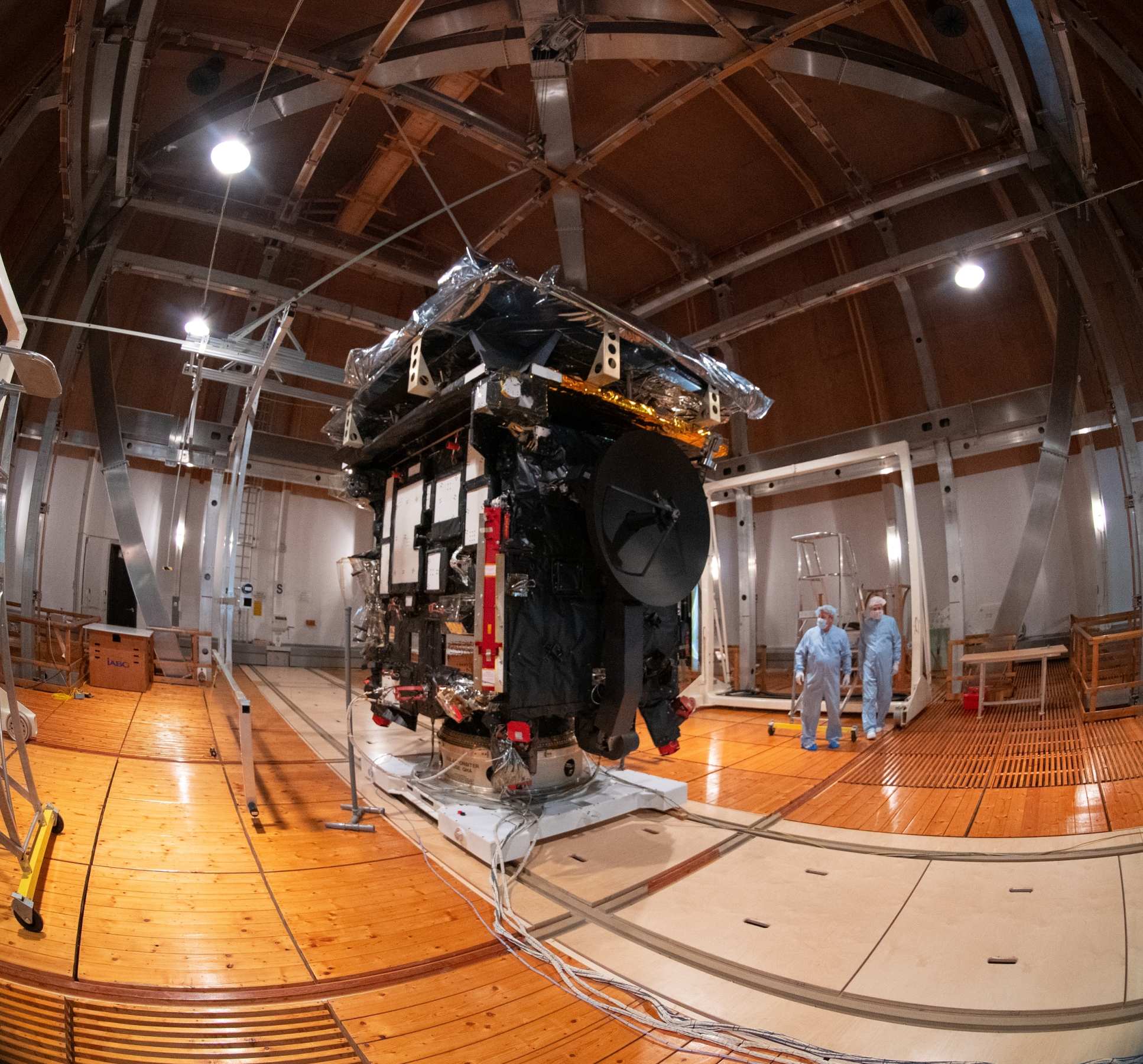
Solar Orbiter inside the testing facility. Credit: ESA–S. Corvaja

An Imperial-built instrument will study the Sun’s magnetic field aboard the Solar Orbiter spacecraft following its launch in early 2020.
Solar Orbiter, a European Space Agency (ESA) mission, will study the Sun in unprecedented detail from only 50 million kilometres away, inside the orbit of Mercury. The spacecraft is due for launch in February 2020 with a suite of ten instruments, one of which is built and led by Imperial scientists.
Solar Orbiter is going to do so much great science in helping us understand how the Sun works and how it affects all our lives. Professor Tim Horbury
Professor Tim Horbury is the Principal Investigator for the magnetometer instrument (MAG) and Helen O’Brien is the lead engineer. Both are from the Department of Physics at Imperial, which hosts several members of the MAG team, which also has members from across Europe and the United States.
Following months of extensive testing to make sure the spacecraft and instruments are ready for flight, the team now awaits launch from NASA’s Cape Canaveral in Florida.
Professor Horbury said: “After all these years working on Solar Orbiter, it’s so exciting to be just five months away from launch. We should start getting measurements back really quickly from the instrument; I won’t stop worrying until we get a look at the real data in flight, but this is a really important step along the way.
“Solar Orbiter is going to do so much great science in helping us understand how the Sun works and how it affects all our lives, and there is a community of scientists, at Imperial, elsewhere in the UK, and around the world, who are itching to get their hands on our measurements!”
Measuring the Sun
The MAG instrument will measure the Sun’s magnetic field in interplanetary space. This field is generated below the surface of the star as it rotates in a similar way to the Earth’s, but it is much more changeable.
The Sun’s magnetic field is carried out into interplanetary space by a flow of particles called the solar wind. When this magnetic field arrives near the Earth, it can interact with our own to produce so-called ‘space weather’, which can disrupt power grids and affect satellites. Solar Orbiter will study the science behind these important events.
At its surface, the Sun’s magnetic field is around twice that of the Earth’s, but in deep space it is tens of thousands of times smaller, so MAG must be incredibly sensitive. This also means the spacecraft itself, and all its other instruments, must not produce significant magnetic fields themselves so as not to interfere with the interplanetary magnetic field.
Stringent testing
The entire Solar Orbiter spacecraft, with all its instruments aboard, was put through a stringent set of magnetic field tests this summer, proving it is magnetically ‘clean’ enough to allow MAG to do its job once in orbit.
The spacecraft was placed in a unique facility run by German company IABG in a forest south of Munich to avoid interference with human-generated magnetic fields.
The facility consists entirely of non-magnetic materials like wood and contains twelve 15-metre coils – nearly as large as the building – which create a consistent magnetic environment that cancels out the Earth’s own magnetic field, simulating outer space conditions.
 Credit: ESA–S. Corvaja
Credit: ESA–S. Corvaja
The testing first characterised the magnetic behaviour of the unpowered spacecraft, to make sure the magnetic field of Solar Orbiter is low enough that the MAG instrument can operate at its most sensitive range.
Later tests used electric current to power the spacecraft and measure possible variations in the spacecraft’s magnetic field during specific operations, for example with extra currents generated by the motors or by mobile elements including the changeable optical filters used by the cameras on board to take images of the Sun.
Huge amount of work
The analysis of the magnetic tests indicates that the mission requirements were largely within the limits of the testing facility. After launch, in the even quieter environment of space, further measurements will complement the results of these tests to fully characterise the magnetic properties of the spacecraft.
Professor Horbury added: “It’s vital that our instrument can measure the tiny magnetic fields in space, so it was a huge relief to finally be able to see the measurements that confirm that the spacecraft magnetic field is nice and small.
“We’re grateful to the huge amount of work that has been put in by everyone at the European Space Agency, Airbus, and all the instrument teams to make this possible.”
Supporters

Article text (excluding photos or graphics) © Imperial College London.
Photos and graphics subject to third party copyright used with permission or © Imperial College London.
Reporter
Hayley Dunning
Communications Division

Contact details
Tel: +44 (0)20 7594 2412
Email: h.dunning@imperial.ac.uk
Show all stories by this author
Leave a comment
Your comment may be published, displaying your name as you provide it, unless you request otherwise. Your contact details will never be published.




Comments
Comments are loading...